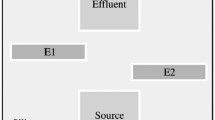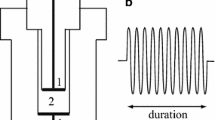Abstract
The electrical and morphological properties of human erythrocytes under high hydrostatic pressure up to 500 MPa have been studied by dielectric spectroscopy. The pressure-induced changes in the dielectric behavior of erythrocyte suspensions indicate that hydrostatic pressure causes the change in cell shape from discoidal to spherical and hemolysis at 200–300 MPa, the formation of buds and spicular processes followed by vesiculation at 300–400 MPa, and the increase in the membrane capacitance at 400–500 MPa. © 1999 Biomedical Engineering Society.
PAC99: 8716Dg, 8716Uv, 8380Lz, 8715La
Similar content being viewed by others
REFERENCES
Asami, K., and T. Hanai. Observations and the phenomenological interpretation of dielectric relaxation due to electrode polarization. Bull. Inst. Chem. Res., Kyoto Univ. 71:111–119, 1993.
Asami, K., T. Hanai, and N. Koizumi. Dielectric approach to suspensions of ellipsoidal particles covered with a shell in particular reference to biological cells. Jpn. J. Appl. Phys. 19:359–365, 1980.
Asami, K., Y. Takahashi, and S. Takashima. Dielectric properties of mouse lymphocytes and erythrocytes. Biochim. Biophys. Acta 1010:49–55, 1989.
Asami, K., Y. Takahashi, and S. Takashima. Frequency domain analysis of membrane capacitance of cultured cells ~Hela and myeloma! using the micropipette technique. Biophys. J. 58:143–148, 1990.
Braganza, L. F., and D. L. Worcester. Hydrostatic pressure induces hydrocarbon chain interdigitation in singlecomponent phospholipid bilayers. Biochemistry 25:2591–2596, 1986.
Bridgeman, P. W. Water, in the liquid and five solid forms, under pressure. Proc. Am. Acad. Arts Sci. 47:439–558, 1912.
Chong, P. L. G. Effects of hydrostatic pressure on the location of PRODAN in lipid bilayers and cellular membranes. Biochemistry 27:399–404, 1988.
Cole, K. S., and R. H. Cole. Dispersion and absorption in dielectrics. I. Alternating current characteristics. J. Chem. Phys. 9:341–351, 1941.
Dunn, L. A., and R. H. Stokes. Pressure and temperature dependence of the electrical permittivities of formamide and water. Trans. Faraday Soc. 65:2906–2912, 1969.
Eisenberg, B., and R. S. Eisenberg. Selective disruption of the sarco-tubular system in frog sartorius muscle. J. Cell Biol. 39:451–467, 1968.
Foster, K. R., and H. P. Schwan. Dielectric properties of tissues and biological materials: A critical review. Crit. Rev. Biomed. Eng. 17:25–104, 1989.
Gross, M., and R. Jaenicke. Proteins under pressure. The influence of high hydrostatic pressure on structure, function and assembly of proteins and protein complexes. Eur. J. Biochem. 22:617–630, 1994.
Hanai, T., K. Asami, and N. Koizumi. Dielectric theory of concentrated suspension of shell-spheres in particular reference to the analysis of biological cell suspensions. Bull. Inst. Chem. Res., Kyoto Univ. 57:297–305, 1979.
Heremans, K. High pressure effects on proteins and other biomolecules. Annu. Rev. Biophys. Bioeng. 11:1–21, 1982.
Kaneko, H., K. Asami, and T. Hanai. Dielectric analysis of sheep erythrocyte ghost. Examination of applicability of dielectric mixture equations. Colloid. Polym. Sci. 269:1039–1044, 1991.
Macdonald, A. The effects of pressure on the molecular structure and physiological functions of cell membranes. Philos. Trans. R. Soc. London, Ser. B 304:47–68, 1984.
Marquis, R. E. High-pressure microbial physiology. Adv. Microb. Physiol. 14:159–241, 1976.
Pauly, H., and H. P. Schwan. Über die Impedanz einer Suspension von kugelförmigen Teilchen mit einer Schale. Z. Naturforsch. B 14:125–131, 1959.
Pethig, R., and D. B. Kell. The passive electrical properties of biological systems: their significance in physiology, biophysics and biotechnology. Phys. Med. Biol. 32:933–970, 1987.
Scarlata, S. F. Compression of lipid membrane as observed at varying membrane positions. Biophys. J. 60:334–340, 1991.
Schwan, H. P. Determination of biological impedance. In: Physical Techniques in Biological Research, Vol. 6, edited by W. L. Nastuk. New York: Academic, 1963, pp. 323–406.
Shimada, S., M. Andou, N. Naito, N. Yamada, M. Osumi, and R. Hayashi. Effects of hydrostatic pressure on the ultra-structure and leakage of internal substances in the yeast Saccharomyces cerevisiae. Appl. Microbiol. Biotechnol. 40:123–131, 1993.
Srinivasan, K. R., and R. L. Kay. Pressure dependence of the dielectric constant of H2O and D2O. J. Chem. Phys. 60:3645–3649, 1974.
Takashima, S. Passive electrical properties and voltage dependent membrane capacitance of single skeletal muscle fibers. Pflugers Arch. Ges. Physiol. Menschen Tiere 403:197–204, 1985.
Takashima, S. Electrical Properties of Biopolymers and Membranes. Bristol: Adam Hilger, 1989.
Weber, G., and H. Drickamer. The effect of high pressure upon proteins and other molecules. Q. Rev. Biophys. 116:89–112, 1983.
Wong, P. T. T., D. J. Siminovitch, and H. H. Mantsch. Structure and properties of model membranes: new knowledge from high-pressure vibrational spectroscopy. Biochim. Biophys. Acta 947:139–171, 1988.
Yamaguchi, T., T. Kajikawa, and E. Kimoto. Vesiculation induced by hydrostatic pressure in human erythrocytes. J. Biochem. (Tokyo) 110:355–359, 1991.
Yamaguchi, T., H. Kawamura, E. Kimoto, and M. Tanaka. Effects of temperature and pH on hemoglobin release from hydrostatic pressure-treated erythrocytes. J. Biochem. (Tokyo) 106:1080–1085, 1989.
Zimmerman, A. H. High pressure studies in cell biology. Int. Rev. Cytol. 30:1–47, 1971.
Author information
Authors and Affiliations
Rights and permissions
About this article
Cite this article
Asami, K., Yamaguchi, T. Electrical and Morphological Changes of Human Erythrocytes under High Hydrostatic Pressure Followed by Dielectric Spectroscopy. Annals of Biomedical Engineering 27, 427–435 (1999). https://doi.org/10.1114/1.190
Issue Date:
DOI: https://doi.org/10.1114/1.190




